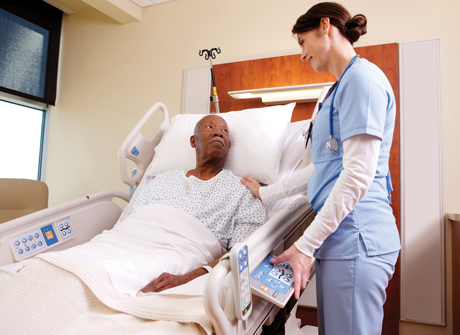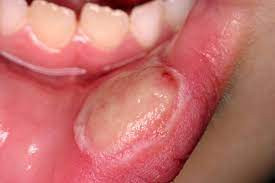Definition
Decubitus ulcers or pressure ulcers are wounds to the skin and its underlying tissues caused by prolonged pressure on the skin. Decubitus ulcers usually affect the skin overlying bony areas, such as the heels, ankles, waist, and tailbone. This condition is a health problem affecting many worldwide, with several thousand patients annually.
Causes
The main factors that play a role in the formation of decubitus ulcers are as follows:
- Pressure. Constant pressure on certain areas of the body can reduce blood flow to the skin in those areas. Blood flow is essential for delivering nutrients and oxygen to the tissues. Without these nutrients, the skin and surrounding tissues are more vulnerable to injury and death. For people with limited movement, this pressure usually appears on parts of the body that are not covered by muscle or thick fat over the bones, such as the spine, tailbone, protrusions on the shoulder blades, waist, heels, and elbows
- Friction. Friction occurs when the skin makes contact with clothing or sheets. This can make the skin more vulnerable to injury, especially if the skin is damp
- Shedding. Shedding occurs when two surfaces move in opposite directions. For example, raising the head section of a bed causes the body to swing downward. As the tailbone descends, the skin lining the bone can remain in place. In other words, the skin "pulls" in the opposite direction
Risk factor
Risk factors for decubitus ulcers are as follows:
- Immobility. Immobility may result from poor health, spinal cord injury, and other causes
- Incontinence. Problems with defecation or urination make the skin more susceptible to wounds due to exposure to urine and feces
- Reduced sensation of the senses. Spinal cord injuries, nerve diseases, and other conditions can cause reduced sensation. The inability to sense pain and discomfort can lead to being unaware of danger signs and the need to reposition oneself
- Poor nutrient and fluid intake. Humans need sufficient fluids, calories, protein, vitamins, and minerals in their daily diet to keep the skin healthy and prevent tissue damage
- Medical conditions that affect blood flow. Health problems that affect blood flow, such as diabetes or vascular disease, can increase the risk of tissue damage in decubitus ulcers
Symptoms
The symptoms of decubitus ulcers are divided into four stages. Usually, stages 1 and 2 do not require surgery, while stages 3 and 4 might.
In stage 1, the skin is not damaged but has a different color. The skin on the affected area may be red, blue, or purple. The color also does not disappear for more than 30 minutes. In addition to the discoloration, the skin may be warm to the touch, swollen, painful, itchy, or burning.
In stage 2, a section of skin opens up, forming an echo or scratch filled with pus. The wound could also appear as a fluid-filled blister. These sores can affect both the outer and inner layers of the skin. They may also be painful and accompanied by discoloration of the surrounding skin.
At stage 3, the wound has reached the fat layer. At this point, however, there are no visible bones or muscles. The wound may resemble a crater and have an unpleasant odor.
In stage 4, the wound is extremely deep and involves multiple layers of tissue, including bone. In addition, there is a lot of dead tissue and pus in the wound. Infection is very likely at this point. Muscles, bones, tendons (the connecting tissue between muscles and bones), and joints may all be visible.
In some cases, determining the depth of a wound can be difficult. These conditions may include eskar and slough. Eskar is a stiff plaque inside the wound that can be yellow, brown, or black. Meanwhile, the slough is dead tissue that has become yellow, green, or brown. To determine the stage of a decubitus ulcer, the doctor must remove the eskar and slough to assess the depth of the wound.
Diagnosis
Diagnosis of decubitus ulcers begins with questions about the patient's medical history and wound examination. The doctor may also collect tissue from the wound (biopsy) for laboratory analysis. To determine the depth of the wound, the doctor may use imaging tests such as a computed tomography (CT) scan or magnetic resonance imaging (MRI).
Management
Treatment and management of decubitus ulcers could involve various healthcare professionals, including medical specialists, nurses, and physiotherapists. The management course is tailored to the specific stage of the decubitus ulcer. The treatments comprise repositioning or changing the patient's position regularly, including supine, lateral, or prone positions. Additionally, maintaining a clean, dry, and irritation-free bed is essential to facilitate the healing process.
Management strategies for decubitus ulcers may encompass the following:
- Addressing existing infections through topical creams, oral medications, or antibiotic injections
- Ulcer care, by cleaning, dressing, and potentially closing ulcers
- Removing dead tissues by certain bandages or methods
- Taking medications to alleviate discomfort
- Regular repositioning
- Minimize friction and moisture at the ulcer site
- Using specific pillows to reduce pressure on the ulcer
- Surgical interventions
Therapeutic interventions may also incorporate negative pressure wound therapy, a technique aimed at absorbing fluid and infection from the wound to accelerate healing. However, managing deep and long-standing ulcers poses additional challenges.
Complications
Decubitus ulcers commonly lead to complications, with wound infection being the most prevalent. Stages 3 and 4 ulcers demand intensive treatment as complications can escalate to life-threatening levels. At these advanced stages, ulcer-associated bacteria may include anaerobic strains that thrive without oxygen. Infections spreading to deep tissue and bones can cause the following conditions:
- Periostitis (infection of the membrane enveloping the bone)
- Osteomyelitis (bone infection)
- Septic arthritis (joint infection)
- Sinus formation (formation of empty spaces due to tissue loss)
Furthermore, infection can infiltrate the bloodstream and trigger sepsis, characterized by an excessive systemic response to infection.
Decubitus ulcers use so much energy that it could lead to significant fluid and protein loss. Prolonged ulcers can also induce anemia due to nutritional deficiency, fluid loss, or bleeding.
Additionally, inadequate management of postoperative decubitus ulcers can result in complications such as hematoma, wound dehiscence, abscess formation, and sepsis.
Prevention
Prevention strategies for decubitus ulcers include:
- Adjust body position every 2 hours
- If you use a wheelchair, maintain an upright sitting position, change seating positions every 15 minutes, or utilize supportive pillows
- Regularly inspect the skin, especially if bedridden or hospitalized
- Use pillows or specialized mattresses to redistribute pressure and prevent new ulcer formation
- Wear properly fitted clothes that are not excessively tight or loose, as well as those prone to bunching up underneath you
- Apply pads to pressure-prone areas such as elbows and heels
- Quit smoking
- Dietary management (collaborate with a nutritionist or nutrition specialist to optimize nutritional intake
- Ensure adequate fluid intake
- Engage in regular physical activity as often as possible, including walking or muscle-stretching exercises several times a day
When to see a doctor?
You should consult with a doctor if you notice any of the following symptoms of a decubitus ulcer, such as:
- Changes in skin color or texture
- Swelling
- Pus discharge
- Localized warmth
- Pain
Consider changing positions to alleviate pressure on the affected area. If symptoms persist or worsen within 24-48 hours, seek medical advice from a healthcare professional.
Additionally, if you observe signs of infection, including fever, malodorous discharge from the ulcer, changes in skin color, warmth, swelling, or increased pain, promptly seek urgent medical attention. Visit the nearest emergency room for immediate evaluation and treatment.
Looking for more information about other diseases? Click here!
- dr Anita Larasati Priyono
Bedsores (pressure ulcers) - Symptoms and causes. (2022). Retrieved 12 May 2022, from https://www.mayoclinic.org/diseases-conditions/bed-sores/symptoms-causes/syc-20355893
Macon, B., & Bard, S. (2021). What You Should Know About Decubitus Ulcers. Retrieved 12 May 2022, from https://www.healthline.com/health/pressure-ulcer
Zaidi, S., & Sharma, S. (2022). Pressure Ulcer. Retrieved 12 May 2022, from https://www.ncbi.nlm.nih.gov/books/NBK553107/











